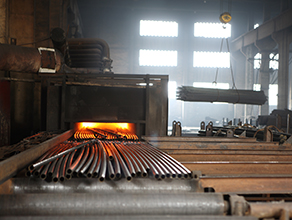
In the manufacturing process of seamless steel tubes, heat treatment is a critical step that determines the product's performance. Annealing and normalizing, as two fundamental and important heat treatment processes, have a fundamental impact on the microstructure and properties of seamless steel tubes. Correctly understanding and selecting the heat treatment process is of great significance for ensuring the quality of seamless steel tubes.
Process Principles and Operational Differences
Annealing involves heating the seamless steel tube to an appropriate temperature (above or below AC1), holding it for a certain time, and then cooling it slowly. Depending on the heating temperature, it can be classified into various types such as full annealing, incomplete annealing, and stress relief annealing. The main characteristic of annealing is the slow cooling rate, usually performed in the furnace, which allows sufficient time for austenite to transform into a balanced microstructure.
Normalizing, on the other hand, involves heating the seamless steel tube to 30-50°C above AC3, holding for an appropriate time, and then cooling naturally in air. Compared to annealing, normalizing involves a slightly higher heating temperature and a faster cooling rate. This faster cooling causes the austenite to transform under less balanced conditions, resulting in a finer microstructure.

Manifestation of Microstructural Differences
Seamless steel tubes subjected to annealing typically obtain a microstructure close to the equilibrium state, with coarser grains and larger pearlite interlamellar spacing. This structural state gives the material lower strength and hardness but better plasticity and toughness. For seamless steel tubes requiring further cold processing, this microstructural condition is more conducive to subsequent processing.
Normalizing results in a finer microstructure, with smaller pearlite interlamellar spacing and finer ferrite grains. This fine-grained structure provides seamless steel tubes with higher strength and hardness while maintaining good toughness.
Comparison of Mechanical Property Impacts
In terms of mechanical properties, normalized seamless steel tubes generally exhibit higher strength, hardness, and toughness. Compared to the annealed condition, the yield strength of normalized material can increase by 10%-15%, tensile strength by 5%-10%, and impact toughness also shows significant improvement. These characteristics make normalized seamless steel tubes more suitable for manufacturing structural components requiring higher strength.
Annealed seamless steel tubes, although having lower strength indices, possess better plasticity and machinability. Their elongation is typically 3%-5% higher than in the normalized condition, and the lower hardness makes them easier to machine.
Process Cost and Production Efficiency
From a production cost perspective, the normalizing process holds a clear advantage. As the cooling process takes place in air, it does not require occupying the heating furnace, leading to shorter production cycles, lower energy consumption, and higher production efficiency. These characteristics make normalizing a more economical heat treatment choice in seamless steel tube production.
The annealing process requires longer cooling times, typically involving furnace cooling, which not only ties up equipment but also increases energy consumption. However, for seamless steel tubes with certain special requirements, annealing is irreplaceable.
Professional Application Selection Advice
When selecting a heat treatment process, the end-use requirements of the seamless steel tube must be considered. For structural tubes requiring higher strength and good toughness, normalizing is recommended. For tubes requiring further cold processing or better machinability, annealing is suggested.
The material factor should also not be overlooked. Low-carbon steel seamless tubes are usually normalized, while medium and high-carbon steels are more often annealed.

Key Points for Quality Control
Regardless of the heat treatment process used, strict control of process parameters is key to ensuring the quality of seamless steel tubes. Heating temperature, holding time, and cooling rate all require precise control. Changzhou Tenjan Steel Tube Co., Ltd. utilizes advanced heat treatment equipment equipped with precise temperature control systems to ensure stable and reliable process parameters.
Quality inspection after heat treatment is equally important. Hardness testing, mechanical property tests, and metallographic analysis are all necessary inspection items.
Conclusion
Annealing and normalizing, as important heat treatment processes in seamless steel tube production, each have their own characteristics and application ranges. Correctly selecting and strictly controlling the heat treatment process is crucial for ensuring that seamless steel tubes achieve the desired properties. Relying on professional technical experience and a complete quality control system, Changzhou Tenjan Steel Tube Co., Ltd. can provide customers with the highest quality heat treatment solutions.
For more information on heat treatment processes for seamless steel tubes or professional technical consultation, please feel free to contact Changzhou Tenjan Steel Tube Co., Ltd. We will provide you with the most suitable products and services using our professional technology and extensive experience.
Contact Us
Tel: 0519-88789990
Website: https://www.tenjan.com/
Home Product Capabilities Case Studies Blogs About Get a Quote
Pipe & Tube Manufacturing Process Shapes & Profiles Pipes & Tubes Material Standard Steel Pipes & Tube Rebar Couplers Cold Drawn Steel Profiles & Bars
Oil & Petrochemical Industry Automotive & Motorcycle Components Mechanical Engineering Components Mining Construction Support Structures High-Pressure Boiler System Construction Machinery Geological Drilling Agricultural Machinery Parts Industrial Fluid Transfer Systems
© 2024 Changzhou Tenjan Steel Tube Co., Ltd All rights reserved. Privacy StatementTerms-ConditionsSitemap